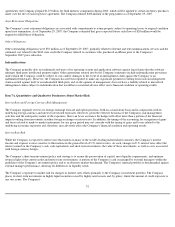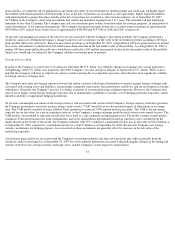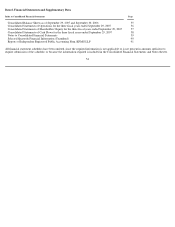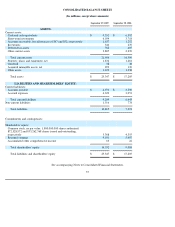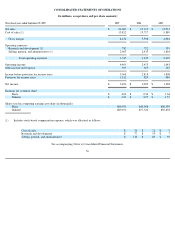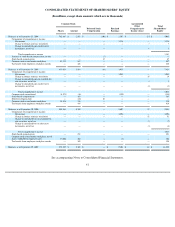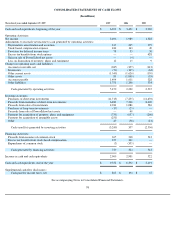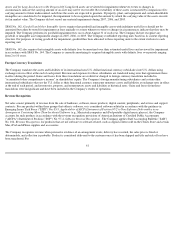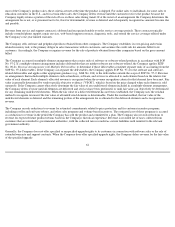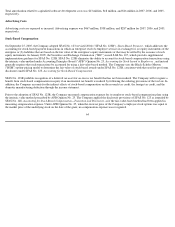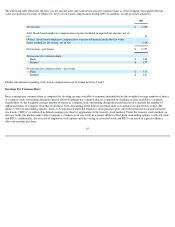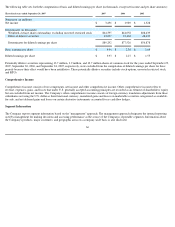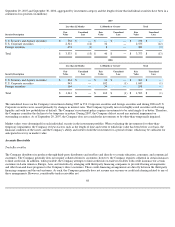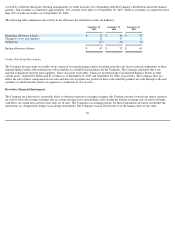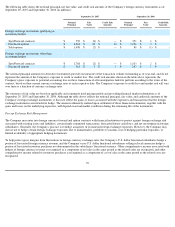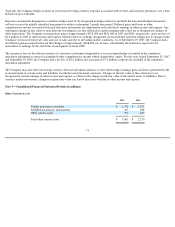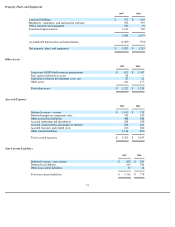Apple 2007 Annual Report Download - page 66
Download and view the complete annual report
Please find page 66 of the 2007 Apple annual report below. You can navigate through the pages in the report by either clicking on the pages listed below, or by using the keyword search tool below to find specific information within the annual report.
most of the Company's product sales, these criteria are met at the time the product is shipped. For online sales to individuals, for some sales to
education customers in the U.S., and for certain other sales, the Company defers revenue until the customer receives the product because the
Company legally retains a portion of the risk of loss on these sales during transit. If at the outset of an arrangement the Company determines the
arrangement fee is not, or is presumed not to be, fixed or determinable, revenue is deferred and subsequently recognized as amounts become due
and payable.
Revenue from service and support contracts is deferred and recognized ratably over the service coverage periods. These contracts typically
include extended phone support, repair services, web-based support resources, diagnostic tools, and extend the service coverage offered under
the Company's one-year limited warranty.
The Company sells software and peripheral products obtained from other companies. The Company establishes its own pricing and retains
related inventory risk, is the primary obligor in sales transactions with its customers, and assumes the credit risk for amounts billed to its
customers. Accordingly, the Company recognizes revenue for the sale of products obtained from other companies based on the gross amount
billed.
The Company accounts for multiple element arrangements that consist only of software or software-related products in accordance with SOP
No. 97
-2. If a multiple-element arrangement includes deliverables that are neither software nor software-related, the Company applies EITF
No. 00
-21, Revenue Arrangements with Multiple Deliverables, to determine if those deliverables constitute separate units of accounting from the
SOP No. 97-2 deliverables. If the Company can separate the deliverables, the Company applies SOP No. 97-2 to the software and software-
related deliverables and applies other appropriate guidance (e.g., SAB No. 104) to the deliverables outside the scope of SOP No. 97-2. Revenue
on arrangements that include multiple elements such as hardware, software, and services is allocated to each element based on the relative fair
value of each element. Each element's allocated revenue is recognized when the revenue recognition criteria for that element have been met. Fair
value is generally determined by vendor specific objective evidence ("VSOE"), which is based on the price charged when each element is sold
separately. If the Company cannot objectively determine the fair value of any undelivered element included in a multiple-element arrangement,
the Company defers revenue until all elements are delivered and services have been performed, or until fair value can objectively be determined
for any remaining undelivered elements. When the fair value of a delivered element has not been established, the Company uses the residual
method to recognize revenue if the fair value of all undelivered elements is determinable. Under the residual method, the fair value of the
undelivered elements is deferred and the remaining portion of the arrangement fee is allocated to the delivered elements and is recognized as
revenue.
The Company records reductions to revenue for estimated commitments related to price protection and for customer incentive programs,
including reseller and end-user rebates, and other sales programs and volume-based incentives. The estimated cost of these programs is accrued
as a reduction to revenue in the period the Company has sold the product and committed to a plan. The Company also records reductions to
revenue for expected future product returns based on the Company's historical experience. Revenue is recorded net of taxes collected from
customers that are remitted to governmental authorities, with the collected taxes recorded as current liabilities until remitted to the relevant
government authority.
Generally, the Company does not offer specified or unspecified upgrade rights to its customers in connection with software sales or the sale of
extended warranty and support contracts. When the Company does offer specified upgrade rights, the Company defers revenue for the fair value
of the specified upgrade
62


